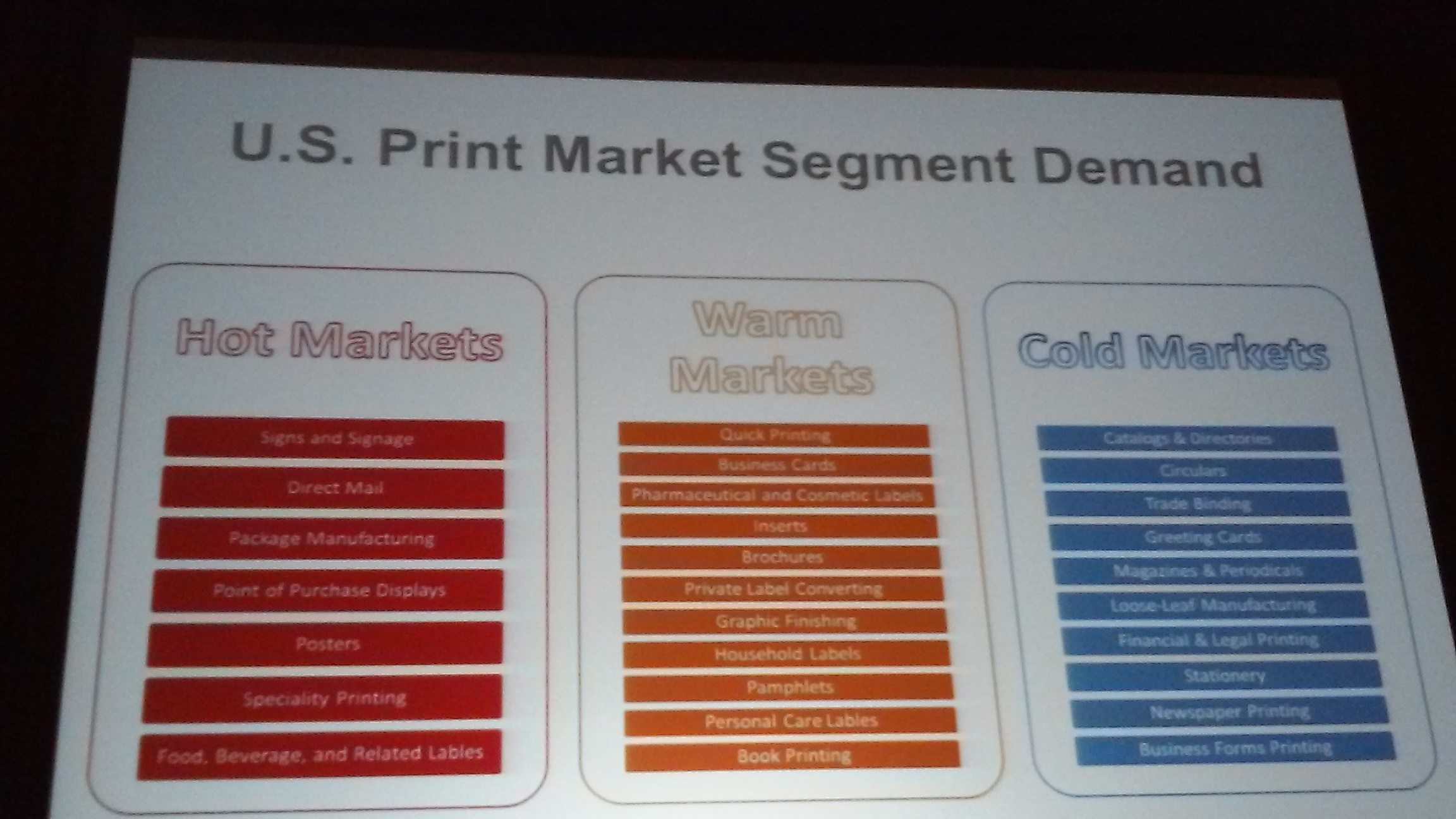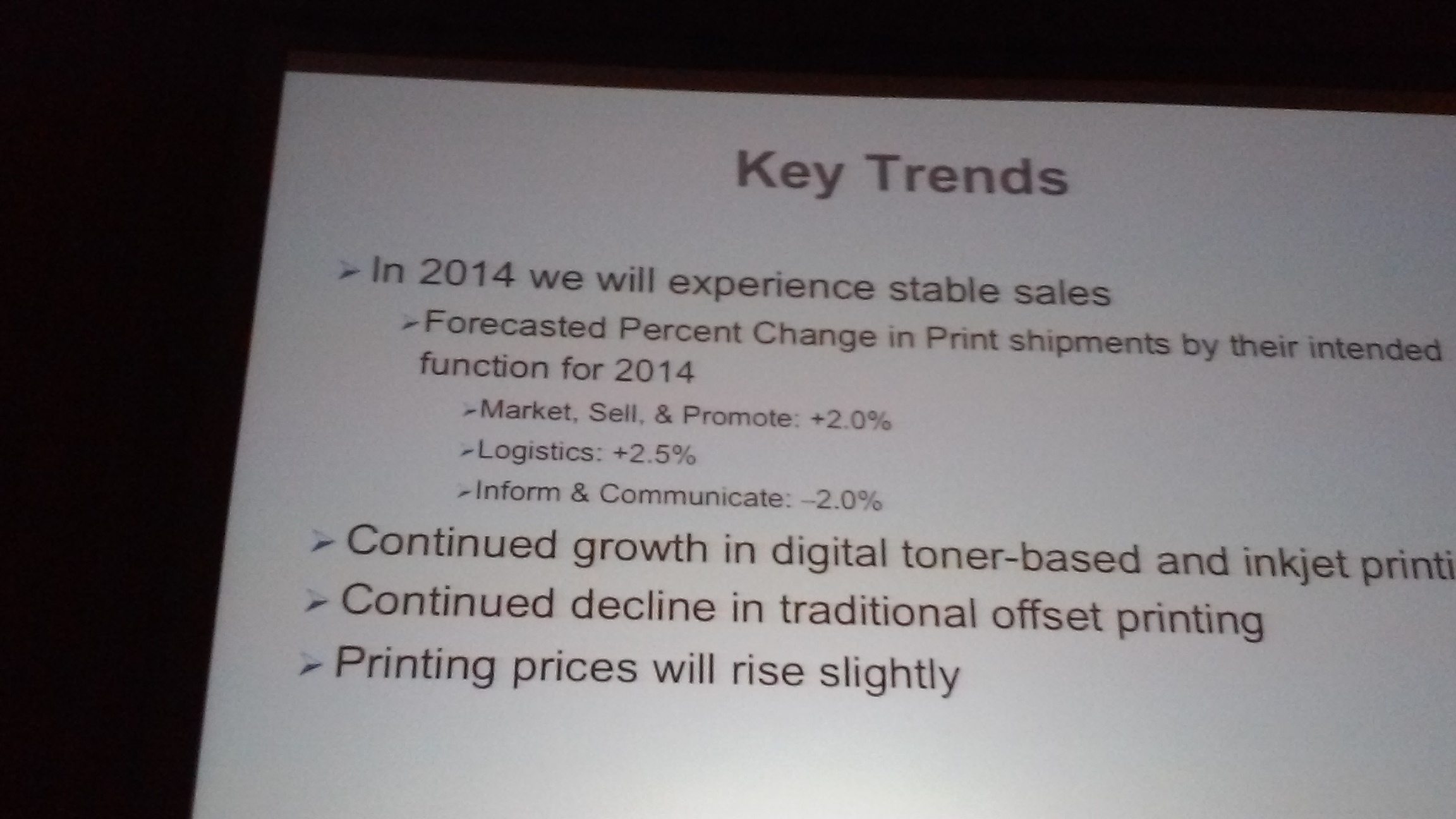Conference Sets a Pivot Point for Futurists, Analysts and Practitioners to Access a 360 View of Industry
The Executive Outlook conference took place the first morning of Graph Expo 2014, setting the stage for the equipment, products and services displayed on the trade show floor. The session — entitled “Print That Performs” — was sponsored by EFI, Xerox and Output Links Communications Group.
In looking at the list of attendees at Executive Outlook, I saw a lot of people like me: journalists and analysts who focus on making predictions about the printing industry.
On the other end of the spectrum were attendees at a pivotal place in their business or organization who need a 360 view of where print is today so they can make decisions about tomorrow.
Organizers Did a Solid Job of Putting Data in Context
From economic indicators to case studies, presentations focused on slicing and dicing the data so attendees could make sense of their own markets and opportunities.
This freeze frame of our industry reminded me of the red tear drop on Google Maps. Navigating your trip is a lot easier when you understand where you are and where you’re headed.
Conference Sets the Stage for Strategic Decisions about the Future
Even though many printing company owners understand their own market sectors, they often don’t have the time to back up and get a perspective elsewhere. Attendees at Executive Outlook were able to get an overview of a variety of sectors — from packaging to inkjet to digital — and to see where others have capitalized on opportunities.
 The case studies, to me, were the most interesting part of the session, as these featured business owners are adapting thoughtfully but swiftly. In addition to revealing their decision making processes, these speakers talked about how their company operates internally in order to be exceptionally responsive to customers and market conditions.
The case studies, to me, were the most interesting part of the session, as these featured business owners are adapting thoughtfully but swiftly. In addition to revealing their decision making processes, these speakers talked about how their company operates internally in order to be exceptionally responsive to customers and market conditions.
Jottings from my Executive Outlook Notebook
The conference kicked off with a welcome presentation by Ralph Nappi, president of Graphic Arts Show Company (GASC).
Here are some points made by presenters (my summary of what they said, not direct quotes) along with my notes from the margins:
The desire to control every aspect of one’s market sector leaves opportunities on the table for other/future sectors. (Jon Budington, Global Printing)
[My addendum: Business owners would be wise to cultivate trusted partners to shed light on a wider swath of opportunities.]
Innovation needs to solve a customer’s problem. (Jon Budington)
[My observation: I believe innovation has to go beyond solving a problem — it has to solve a concept or larger framework for a true revolution to occur.]
The cost of print production is just one part of the print buyer’s total cost, which includes creation and distribution. (Jon Budington)
[Not mentioned: Archiving and repurposing also are part of the total cost of printing these days.]
“Print that informs” is going away in paper form. (Hal Hinderliter, Hal Hinderliter Consulting Services)
[My assertion: Readers love print on paper, but publishers aren’t doing enough to create formats that suit today’s multi-connected readers.]
Print customers are making decisions about who they will print with before they ever contact the company, based on Google searches. (Joe Rickard, Intellective Solutions)
[My contention: Too little attention was paid in this session to the power of social media. There are social media influencers whose opinions and recommendations reach print buyers around the world, not just in their local markets.]
If the dogs aren’t eating the dog food, don’t blame the dog. (Joe Rickard)
[My note: I like that quote, which referred to Joe’s reason why designers don’t attend events at print shops. I would like to add that not all education and promotion about your company needs to go to your direct customers and prospects. That’s a lesson we’ve learned from social media. You need to cultivate an atmosphere of your business’ ubiquity, which means influencers in all walks of life need to be aware of what you do and how you conduct yourself.]
 If you remove “print that informs and communicates” from the stats on our industry and include the increase expected from inkjet, we’re looking at a positive number for growth for 2015. (Ed Gleeson, Printing Industries of America)
If you remove “print that informs and communicates” from the stats on our industry and include the increase expected from inkjet, we’re looking at a positive number for growth for 2015. (Ed Gleeson, Printing Industries of America)
[My bleating into the wind: Why is no one helping publishers become profitable? Why does publishing have to be surgically extracted from our industry in order to paint a rosy picture of its future? Publishers, why aren’t you learning from social and digital models and iterating on the fly? Why do you feel the need to create a proprietary platform for everything you do before you step out on the ledge? Why can’t you shed your habits, fears and need for control and just focus on the money trail that is right in front of you?]
There needs to be one or more marketing evangelists within the printing company who know how to integrate campaigns and identify profitable sectors. (Robert Ross, CCG Marketing Solutions)
[My thought bubble: Companies work so hard to find customers who aren’t even a good fit. Start with customers who are aligned with your values, practices and standards. There are prospective customers waiting for a company just like yours to do business with!]
In a recent campaign, direct mail response went up with each subsequent event reminder. (Sabine Lenz, PaperSpecs)
[My two cents: I have found this to be true as well, not only for direct mail but for social media and email. While some recipients are turned off by the multi-channel reminders, others rely on them as just-in-time notifications to manage their busy lives. Great job, Sabine!]
Give your internal teams a bit of a budget and an environment to experiment. (Scott Gray, MET Fine Printers)
[My aside: I absolutely love this advice. Although we hear the maxims “Fail Faster” and “Go Big or Stay Home,” the truth is that most manufacturing companies are not able to weather too much failure, both financially and culturally. When a company runs on repeatability and systems, the focus is usually on refining success by degrees, which converts dimes to dollars. Going too far afield with new processes or products is expensive. Creating safe places where teams can innovate is brilliant.]
Attending Executive Outlook at Graph Expo 2014 gave me many data points from a variety of studies and customer success stories to get a sharply focused snapshot of how the printing industry and its allied sectors are faring right now. Having that pivot point with a 360 view is a valuable tool for companies making strategic decisions in the coming year.
Organizers crammed a lot of information into the half-day session, including a summary of the winners of the Graph Expo “Must See ‘Ems.” However, next year I would love to hear a panel of futurists talk about what they see for the extended view of our industry, including the role of social media!
If you attended, I’d love to hear your opinion, and I look forward to seeing you at Executive Outlook in 2015.
 Sandy Hubbard is a contributor for Print Media Centr, a global media platform targeted to visionaries involved in all aspects of print and media. She also is moderator of #PrintChat, an online weekly conversation among graphic communications professionals around the world, hosted by Deborah Corn of Print Media Centr. In her own practice, Sandy is a Marketing Strategist who works with print-related companies in extreme growth mode.
Sandy Hubbard is a contributor for Print Media Centr, a global media platform targeted to visionaries involved in all aspects of print and media. She also is moderator of #PrintChat, an online weekly conversation among graphic communications professionals around the world, hosted by Deborah Corn of Print Media Centr. In her own practice, Sandy is a Marketing Strategist who works with print-related companies in extreme growth mode.
Special thank you to Melissa DiVietri for the header photo of Hal Hinderliter describing the Graph Expo Must See ‘Ems. See more show photos at http://melissadivietri.com/











